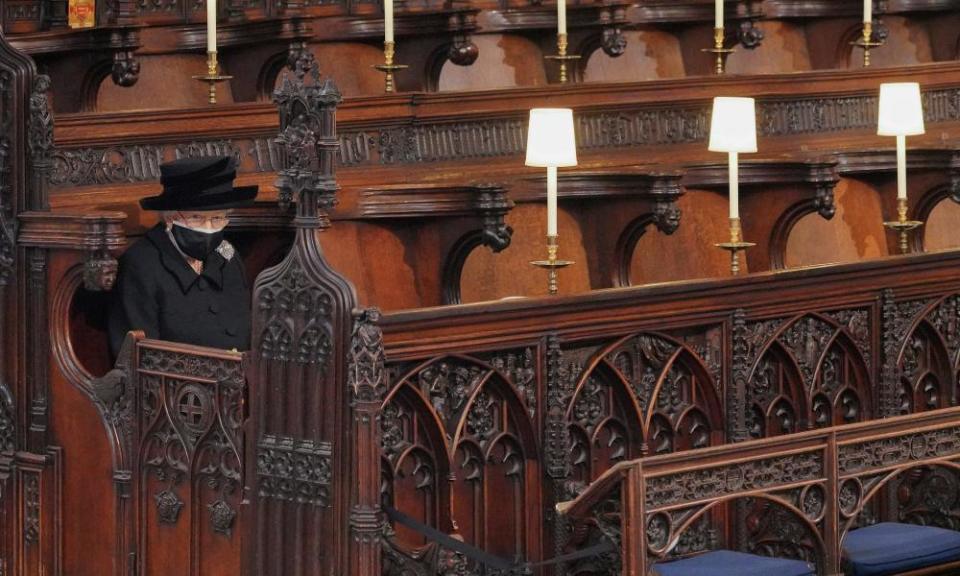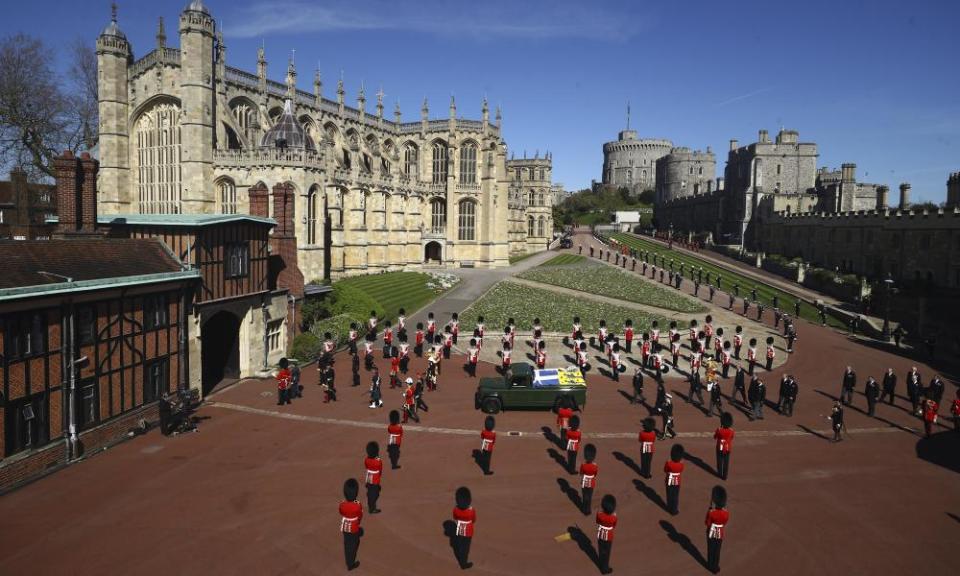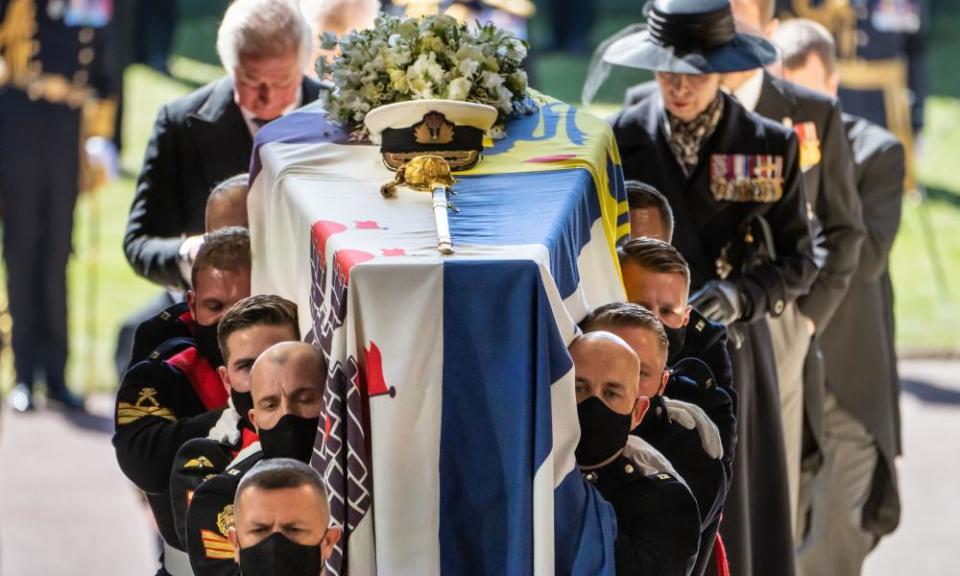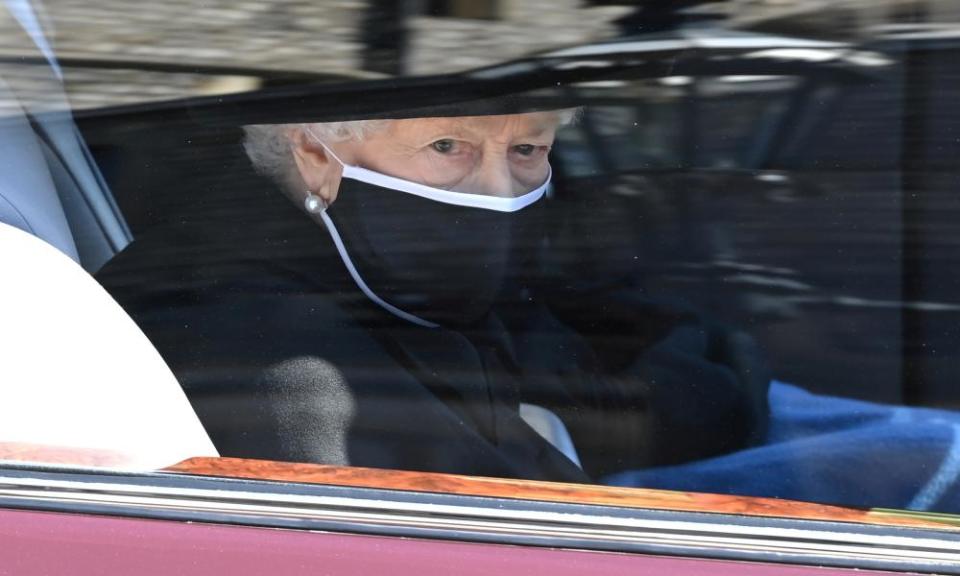Queen alone with her thoughts as duke is laid to rest at Windsor

Nearly everything about the setting itself must have felt touchingly familiar. Just before 3pm the Queen took her usual place in the corner oak pew under the ancient banners of the Knights of the Garter in St George’s Chapel, Windsor – her family’s “home” church. It was a seat she had occupied countless times for Sunday communion, for christenings and weddings and funerals. Only this time, for what must have seemed the first time, her consort and husband, her “strength and stay” of almost 75 years was not sitting beside her. During yesterday’s funeral service for Prince Philip, the monarch remained steadfast as ever, head down, perhaps grateful for her black mask, with only the ever-present cameras for company. In her bubble of one, however, socially distanced from the sparse congregation around her, it went without saying that she had never looked quite so alone.
Until last March the only funerals that many of us had ever watched on screens had probably been royal ones. Princess Diana’s, maybe the Queen Mother’s. The long months of pandemic have made virtual send-offs horribly commonplace, though. Death and farewells have come to Zoom and Facebook Live. That fact gave a particular poignancy to yesterday’s events, attended by only 30 of Philip’s family and closest friends, instead of the planned 800.
Watching the progress of the duke’s coffin, topped with his personal standard and naval cap and sword, through the empty, echoing chapel nave on TV was to be reminded of a reality that so many tens of thousands of families have lately had to suffer. The fact is that without the consolations of hugs and belted-out hymns, without a scrum of shoulders to weep on and old faces to recognise, you are left with a more austere, perhaps hollower, sense of an ending.

There have been suggestions that this is the kind of departure that in his gruff way the Duke of Edinburgh always craved – finally, his prayers for “less fuss” had been answered (though who really, in their heart of hearts, wants a low-key wake?). For once there were no hangers-on, no celebrities, no politicians, no foreign dignitaries. The restrictions on numbers also provided a sound excuse to avoid the potential awkwardnesses that a larger gathering might have exposed. Harry was there – the first time he had seen his family in a fractious year – but obviously without Meghan, who was back at home in California, no doubt tuning in. Prince Andrew was in attendance with his daughters, but obviously no Sarah Ferguson. Never can a guest list have been so straightforward for the Lord Chamberlain’s office.
The lack of pomp beyond military bands resplendent in the spring sunshine and bowed-head grenadiers felt in keeping with some of the more singular arrangements that the duke had set in place. Windsor had always been home turf for him. The best of the BBC tributes followed him doing his daily rounds as ranger of Windsor Great Park, a position he held from 1952 right up until this year. Those drives around the estate were replicated in his final journey, on the back of his favourite Land Rover Discovery, specially modified to his instruction as a hearse, and repainted in military green. He had commissioned the vehicle in 2002, and was still making adaptations to it a couple of years ago. It gave, as he no doubt hoped, a more rugged, mess-tent feel to proceedings. Watching it, as the cortege passed the empty pony trap with his gloves and cap on its seat and his two favourite black fell ponies harnessed up, the words of that old Bing Crosby weepy The Old Man (“We’ll follow the old man wherever he wants to go”) came to mind.
Much had been made of the fact that, as they made the long walk behind the Land Rover that carried their grandfather’s coffin, William and Harry would be separated by their cousin Peter Phillips. Royal sources inevitably explained that arrangement with typically arcane formulae – age plus heir on the right equals spare on the left, or some such. The cameras closed in on the faces of the brothers for hints of side-eye animosity or sparks of the old camaraderie, but they reflected only blank sadness. The fact that the first time they walked behind a hearse it was with Prince Philip beside them (“If I do it, will you?” he is said to have asked the boys before their mother’s funeral) cannot have made those steps to the chapel any easier.

The service, conducted by David Conner, dean of Windsor, and Justin Welby, archbishop of Canterbury, was sombre and liturgically exact, without personal eulogy and certainly with none of the gestures towards modern worship that had caused the duke to raise an alarmed eyebrow at Harry and Meghan’s wedding. No doubt in setting out his wishes for the service he felt, correctly, that more than enough would have been said and written about him by then. His faith, we have learned in the last week, did not stray beyond the covers of the Book of Common Prayer. His favourite seafarer’s hymn, Eternal Father, Strong To Save, could be sung by only four vocalists, though their sound swelled to fill the space.
If there has been one theme of those tributes and memories that have been shared in the past week, on the BBC, in parliament and beyond, it was that for all the requirements of his role, the Duke of Edinburgh was always his own man. Through his heroics on HMS Valiant during the second world war war, to a lifetime of state visits and royal duties, through four children, eight grandchildren and 10 great grandchildren, through the triumphs and disasters of a life in the public eye – he remained recognisably the boy whose character was formed in the spartan environment of his schooldays. He resolutely did things his way.
That spirit seemed to characterise his final word. After the Last Post had been played and as his coffin was being lowered into the royal vault, the duke had requested the bugle call of Action Stations to ring around the chapel – the traditional rallying cry on a naval warship to signify that all hands should ready themselves for battle. As with many of his pronouncements in life, his divided family were left to wonder at the precise meaning of this stirring call to arms. The absence of military uniforms among the royal party appears to have been an edict from the Queen to spare Harry the complications of not being in full regalia after he was stripped of military titles following his departure from “frontline royal duties”. The unfamiliarity of morning suits in among the Queen’s regiments added to the sense that this was an unusual occasion. At his first Buckingham Palace visits as a young man it was noted that Prince Philip had nothing to wear but his “shabby” naval uniform with its “after-the-war look”. In the years that followed, he remained a link to a generation that had come through those hardships.

If it has had a purpose in those years, the monarchy has provided a collective focus for the universal staging posts of all our lives, births, deaths and marriages, bringing emotion and empathy to the idea of the state. That function really came of age with the current Queen and her husband, who allowed the cameras to roll at her coronation. It is a relationship with the public that has provided, for better and worse, some of the exclamation marks of her long reign ever since. In some ways this looked like a turning point in that story, the end of an era.
The Queen turns 95 on Wednesday 21 April. The archbishop of Canterbury, who pronounced the blessing, has praised her “extraordinary dignity and courage” while saying goodbye to her husband. As she left the chapel, to be driven the few hundred yards home, with her family following on foot, William chatting to his brother, you were reminded how in all her years of broadcasts and speeches the only truly memorable quotation that the Queen has provided from the royal stage is that indelible idea that “grief is the price we pay for love”. No doubt, in the back of that car, that phrase was never nearer to her thoughts.

 Yahoo Movies
Yahoo Movies 